Identification of Candidate Genes Associated with Flesh Firmness by Combining QTL Mapping and Transcriptome Profiling in Pyrus pyrifolia
Abstract
1. Introduction
2. Results
2.1. QTL Mapping of Flesh Firmness
2.2. The Polymorphism of Marker1512129 in qFirmness-LG14
2.3. Gene Annotation in QTL Related Intervals
2.4. Flesh Firmness in Fruit Development and RNA-Seq Analysis
2.5. Differentially Expressed Genes (DEGs) Related to Firmness
2.6. Candidate Gene Expression Within Target Intervals of qFirmness-LG14
3. Discussion
4. Material and Methods
4.1. Plant Materials
4.2. Evaluation of Flesh Firmness
4.3. QTL Mapping
4.4. RNA Extraction and RNA-Seq
4.5. Identification of Significantly Differentially Expressed Genes (DEGs)
4.6. Kompetitive Allele Specific PCR (KASP) Primer Design and Detection
4.7. Expression Analysis of Quantitative Real-Time PCR
Supplementary Materials
Author Contributions
Funding
Institutional Review Board Statement
Informed Consent Statement
Data Availability Statement
Conflicts of Interest
References
- Wang, D.D.; Yeats, T.H.; Uluisik, S.; Rose, J.K.C.; Seymour, G.B. Fruit softening: Revisiting the role of pectin. Trends Plant Sci. 2018, 23, 302–310. [Google Scholar] [CrossRef] [PubMed]
- King, G.J.; Maliepaard, C.; Lynn, J.R.; Alston, F.H.; Durel, C.E.; Evans, K.M.; Griffon, B.; Laurens, F.; Manganaris, A.G.; Schrevens, E. Quantitative genetic analysis and comparison of physical and sensory descriptors relating to fruit flesh firmness in apple (Malus pumila Mill.). Theor. Appl. Genet. 2000, 100, 1074–1084. [Google Scholar] [CrossRef]
- Cevik, V.; Ryder, C.D.; Popovich, A.; Manning, K.; King, G.J.; Seymour, G.B. A FRUITFULL-like gene is associated with genetic variation for fruit flesh firmness in apple (Malus domestica Borkh.). Tree Genet. Genomes 2010, 6, 271–279. [Google Scholar] [CrossRef]
- Su, Q.F.; Li, X.L.; Wang, L.X.; Wang, B.C.; Feng, Y.F.; Yang, H.J.; Zhao, Z.Y. Variation in cell wall metabolism and flesh firmness of four apple cultivars during fruit development. Foods 2022, 11, 3518. [Google Scholar] [CrossRef] [PubMed]
- Suojala-Ahlfors, T. Fruit firmness of pickling cucumber cultivars. Horttechnology 2005, 15, 777–781. [Google Scholar] [CrossRef]
- Zhang, C.H.; Xiong, Z.H.; Yang, H.Y.; Wu, W.L. Changes in pericarp morphology, physiology and cell wall composition account for flesh firmness during the ripening of blackberry (spp.) fruit. Sci. Hortic. 2019, 250, 59–68. [Google Scholar] [CrossRef]
- Soteriou, G.A.; Siomos, A.S.; Gerasopoulos, D.; Rouphael, Y.; Georgiadou, S.; Kyriacou, M.C. Biochemical and histological contributions to textural changes in watermelon fruit modulated by grafting. Food Chem. 2017, 237, 133–140. [Google Scholar] [CrossRef]
- Romero, P.; Rose, J.K.C. A relationship between tomato fruit softening, cuticle properties and water availability. Food Chem. 2019, 295, 300–310. [Google Scholar] [CrossRef]
- Costa, F. MetaQTL analysis provides a compendium of genomic loci controlling fruit quality traits in apple. Tree Genet. Genomes 2015, 11, 819. [Google Scholar] [CrossRef]
- Yamamoto, T.; Terakami, S.; Takada, N.; Nishio, S.; Onoue, N.; Nishitani, C.; Kunihisa, M.; Inoue, E.; Iwata, H.; Hayashi, T.; et al. Identification of QTLs controlling harvest time and fruit skin color in Japanese pear (Pyrus pyrifolia Nakai). Breed. Sci. 2014, 64, 351–361. [Google Scholar] [CrossRef]
- Serra, O.; Giné-Bordonaba, J.; Eduardo, I.; Bonany, J.; Echeverria, G.; Larrigaudière, C.; Arús, P. Genetic analysis of the slow-melting flesh character in peach. Tree Genet. Genomes 2017, 13, 77. [Google Scholar] [CrossRef]
- Nantawan, U.; Kanchana-udomkan, C.; Bar, I.; Ford, R. Linkage mapping and quantitative trait loci analysis of sweetness and other fruit quality traits in papaya. BMC Plant Biol. 2019, 19, 449. [Google Scholar] [CrossRef] [PubMed]
- Wu, B.; Shen, F.; Chen, C.J.; Liu, L.; Wang, X.; Zheng, W.Y.; Deng, Y.; Wang, T.; Huang, Z.Y.; Xiao, C.; et al. Natural variations in a pectin acetylesterase gene, contribute to prolonged apple fruit shelf life. Plant Genome 2021, 14, e20084. [Google Scholar] [CrossRef] [PubMed]
- Yang, X.L.; Wu, B.; Liu, J.; Zhang, Z.Y.; Wang, X.; Zhang, H.E.; Ren, X.J.; Zhang, X.; Wang, Y.; Wu, T.; et al. A single QTL harboring multiple genetic variations leads to complicated phenotypic segregation in apple flesh firmness and crispness. Plant Cell Rep. 2022, 41, 2379–2391. [Google Scholar] [CrossRef] [PubMed]
- Zhou, Y.M.; Shen, Q.H.; Cai, L.M.; Zhao, H.S.; Zhang, K.J.; Ma, Y.Y.; Bo, Y.M.; Lyu, X.L.; Yang, J.H.; Hu, Z.Y.; et al. Promoter variations of gene determines flesh firmness in watermelon. BMC Plant Biol. 2024, 24, 290. [Google Scholar] [CrossRef]
- Su, Q.F.; Yang, H.J.; Li, X.L.; Zhong, Y.W.; Feng, Y.F.; Li, H.F.; Tahir, M.M.; Zhao, Z.Y. Upregulation of PECTATE LYASE5 by a NAC transcription factor promotes fruit softening in apple. Plant Physiol. 2024, kiae428. [Google Scholar] [CrossRef]
- Fabrizio, C.; Peace, C.P.; Sara, S.; Sara, S.; Stefano, M.; Micaela, B.; Silviero, S.; Eric, V.D.W.W. QTL dynamics for fruit firmness and softening around an ethylene-dependent polygalacturonase gene in apple (Malus × domestica Borkh.). J. Exp. Bot. 2010, 61, 3029–3039. [Google Scholar]
- Wakasa, Y.; Kudo, H.; Ishikawa, R.; Akada, S.; Senda, M.; Niizeki, M.; Harada, T. Low expression of an endopolygalacturonase gene in apple fruit with long-term storage potential. Postharvest Biol. Technol. 2006, 39, 193–198. [Google Scholar] [CrossRef]
- Yang, Y.; Ma, R.; Zhang, B.; Song, Z.; Zhang, C. Different expression analysis in fruit softening and ethylene biosynthetic pathways in peaches of different flesh textures. Hortic. Plant J. 2016, 2, 75–81. [Google Scholar] [CrossRef][Green Version]
- Qian, M.; Xu, Z.; Zhang, Z.H.; Li, Q.; Yan, X.Y.; Liu, H.K.; Han, M.Y.; Li, F.R.; Zheng, J.C.; Zhang, D.; et al. The downregulation of and influences peach fruit texture and softening. Planta 2021, 254, 22. [Google Scholar] [CrossRef]
- Jiang, S.; Luo, J.; Wang, X.Q.; An, H.S.; Zhang, J.Y.; Li, S.G. QTL mapping and transcriptome analysis to identify genes associated with green/russet peel in Pyrus pyrifolia. Sci. Hortic. 2022, 293, 110714. [Google Scholar] [CrossRef]
- Lee, U.Y.; Chun, J.P. Evaluation of quality indices during fruit development and ripening in ‘Wonhwang’ and ‘Whasan’ pears. Korean J. Agric. Sci. 2011, 38, 405–411. [Google Scholar]
- Byun, J.K.; Kang, I.K.; Chang, K.H.; Kim, D.H.; Lee, D.H.; Kim, I.S.; Shin, S.L.; Choi, D.G. Changes of pectic substances and Polygalacturonase activity during fruit development of various peach cultivars with degrees of fruit softening. J. Korean Soc. Hortic. Sci. 2003, 44, 503–507. [Google Scholar]
- Amorós, A.; Zapata, P.; Pretel, M.T.; Botella, M.A.; Serrano, M. Physico-chemical and physiological changes during fruit development and ripening of five loquat (Lindl.) cultivars. Food Sci. Technol. Int. 2003, 9, 43–51. [Google Scholar] [CrossRef]
- Kunihisa, M.; Moriya, S.; Abe, K.; Okada, K.; Haji, T.; Hayashi, T.; Kim, H.; Nishitani, C.; Terakami, S.; Yamamoto, T. Identification of QTLs for fruit quality traits in Japanese apples: QTLs for early ripening are tightly related to preharvest fruit drop. Breed. Sci. 2014, 64, 240–251. [Google Scholar] [CrossRef]
- Kumar, S.; Kirk, C.; Deng, C.; Wiedow, C.; Knaebel, M.; Brewer, L. Genotyping-by-sequencing of pear (Pyrus spp.) accessions unravels novel patterns of genetic diversity and selection footprints. Hortic. Res. 2017, 4, 17015. [Google Scholar] [CrossRef]
- Qin, M.F.; Li, L.T.; Singh, J.; Sun, M.Y.; Bai, B.; Li, S.W.; Ni, J.P.; Zhang, J.Y.; Zhang, X.; Wei, W.L.; et al. Construction of a high-density bin-map and identification of fruit quality-related quantitative trait loci and functional genes in pear. Hortic. Res. 2022, 9, uhac141. [Google Scholar] [CrossRef]
- Anees, M.; Gao, L.; Umer, M.J.; Yuan, P.L.; Zhu, H.J.; Lu, X.Q.; He, N.; Gong, C.S.; Kaseb, M.O.; Zhao, S.J.; et al. Identification of key gene networks associated with cell wall components leading to flesh firmness in watermelon. Front. Plant Sci. 2021, 12, 630243. [Google Scholar] [CrossRef]
- Miedes, E.; Lorences, E.P. Xyloglucan endotransglucosylase/hydrolases (XTHs) during tomato fruit growth and ripening. J. Plant Physiol. 2009, 166, 489–498. [Google Scholar] [CrossRef]
- Hayashi, T.; Kaida, R. Functions of Xyloglucan in Plant Cells. Mol. Plant 2011, 4, 17–24. [Google Scholar] [CrossRef]
- Atkinson, R.G.; Johnston, S.L.; Yauk, Y.K.; Sharma, N.N.; Schröder, R. Analysis of xyloglucan endotransglucosylase/hydrolase (XTH) gene families in kiwifruit and apple. Postharvest Biol. Technol. 2009, 51, 149–157. [Google Scholar] [CrossRef]
- Miedes, E.; Herbers, K.; Sonnewald, U.; Lorences, E.P. Overexpression of a cell wall enzyme reduces xyloglucan depolymerization and softening of transgenic tomato fruits. J. Agr. Food Chem. 2010, 58, 5708–5713. [Google Scholar] [CrossRef] [PubMed]
- Miedes, E.; Suslov, D.; Vandenbussche, F.; Kenobi, K.; Ivakov, A.; Van Der Straeten, D.; Lorences, E.P.; Mellerowicz, E.J.; Verbelen, J.P.; Vissenberg, K. Xyloglucan endotransglucosylase/hydrolase (XTH) overexpression affects growth and cell wall mechanics in etiolated Arabidopsis hypocotyls. J. Exp. Bot. 2013, 64, 2481–2497. [Google Scholar] [CrossRef] [PubMed]
- Burko, Y.; Gaillochet, C.; Seluzicki, A.; Chory, J.; Busch, W. Local HY5 activity mediates hypocotyl growth and shoot-to-root communication. Plant Commun. 2020, 1, 100078. [Google Scholar] [CrossRef] [PubMed]
- Wang, Y.Y.; Zhang, X.D.; Zhao, Y.R.; Yang, J.; He, Y.Y.; Li, G.C.; Ma, W.R.; Huang, X.L.; Su, J. Transcription factor PyHY5 binds to the promoters and regulates its expression in red pear ‘Yunhongli No. 1’. Plant Physiol. Bioch. 2020, 154, 665–674. [Google Scholar] [CrossRef]
- Müller, M.; Munné-Bosch, S. Ethylene Response Factors: A key regulatory hub in hormone and stress signaling. Plant Physiol. 2015, 169, 32–41. [Google Scholar] [CrossRef]
- Gao, J.; Zhang, Y.X.; Li, Z.G.; Liu, M.C. Role of ethylene response factors (ERFs) in fruit ripening. Food Qual. Saf-Oxf. 2020, 4, 15–19. [Google Scholar] [CrossRef]
- Marín-Rodríguez, M.C.; Orchard, J.; Seymour, G.B. Pectate lyases, cell wall degradation and fruit softening. J. Exp. Bot. 2002, 53, 2115–2119. [Google Scholar] [CrossRef]
- Uluisik, S.; Seymour, G.B. Pectate lyases: Their role in plants and importance in fruit ripening. Food Chem. 2020, 309, 125559. [Google Scholar] [CrossRef]
- Philippe, F.; Pelloux, J.; Rayon, C. Plant pectin acetylesterase structure and function: New insights from bioinformatic analysis. BMC Genom. 2017, 18, 456. [Google Scholar] [CrossRef]
- Pelloux, J.; Rustérucci, C.; Mellerowicz, E.J. New insights into pectin methylesterase structure and function. Trends Plant Sci. 2007, 12, 267–277. [Google Scholar] [CrossRef] [PubMed]
- Wang, J.H.; Sun, Q.; Ma, C.N.; Wei, M.M.; Wang, C.K.; Zhao, Y.W.; Wang, W.Y.; Hu, D.G. MdWRKY31-MdNAC7 regulatory network: Orchestrating fruit softening by modulating cell wall-modifying enzyme MdXTH2 in response to ethylene signalling. Plant Biotechnol. J. 2024. [Google Scholar] [CrossRef] [PubMed]
- Wang, T.T.; Liu, J.C.; Yuan, Y.B.; Wang, Y.; Cheng, C.X.; Yang, S.L. PpWRKY65 mediates peach (Prunus persica) fruit lignification in both ambient temperature storage and chilling injury condition. Postharvest Biol. Technol. 2024, 216, 113043. [Google Scholar] [CrossRef]
- Song, C.B.; Shan, W.; Kuang, J.F.; Chen, J.Y.; Lu, W.J. The basic helix-loop-helix transcription factor MabHLH7 positively regulates cell wall-modifying-related genes during banana fruit ripening. Postharvest Biol. Technol. 2020, 161, 111068. [Google Scholar] [CrossRef]
- Hu, Y.; Han, Z.; Sun, Y.; Wang, S.; Wang, T.; Wang, Y.; Xu, K.; Zhang, X.; Xu, X.; Han, Z.; et al. ERF4 affects fruit firmness through TPL4 by reducing ethylene production. Plant J. Cell Mol. Biol. 2020, 103, 937–950. [Google Scholar] [CrossRef]
- Liu, D.Y.; Ma, C.X.; Hong, W.G.; Huang, L.; Liu, M.; Liu, H.; Zeng, H.P.; Deng, D.J.; Xin, H.G.; Song, J.; et al. Construction and analysis of High-Density Linkage Map using High-Throughput sequencing data. PLoS ONE 2014, 9, e98855. [Google Scholar] [CrossRef]
- Ooijen, J.W.V. MapQTL 6, Software for the Mapping of Quantitative Trait Loci in Experimental Populations of Diploid Species; Kyazma B.V.: Wageningen, The Netherlands, 2009. [Google Scholar]
- Gao, Y.; Yang, Q.; Yan, X.; Wu, X.; Yang, F.; Li, J.; Wei, J.; Ni, J.; Ahmad, M.; Bai, S.; et al. High-quality genome assembly of ‘Cuiguan’ pear (Pyrus pyrifolia) as a reference genome for identifying regulatory genes and epigenetic modifications responsible for bud dormancy. Hortic. Res. 2021, 8, 197. [Google Scholar] [CrossRef]
- Kim, D.; Langmead, B.; Salzberg, S.L. HISAT: A fast spliced aligner with low memory requirements. Nat. Methods 2015, 12, 357–360. [Google Scholar] [CrossRef]
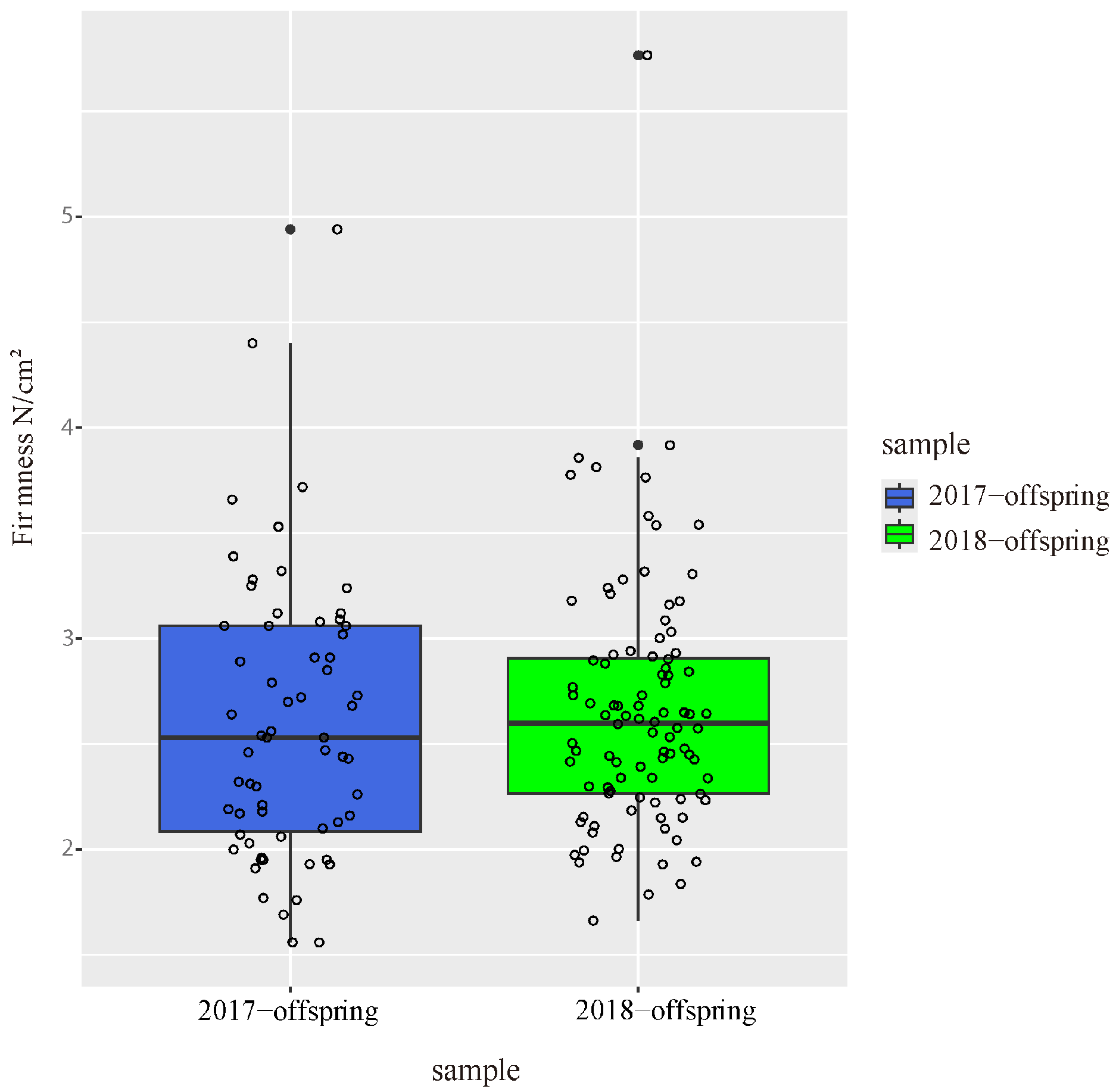
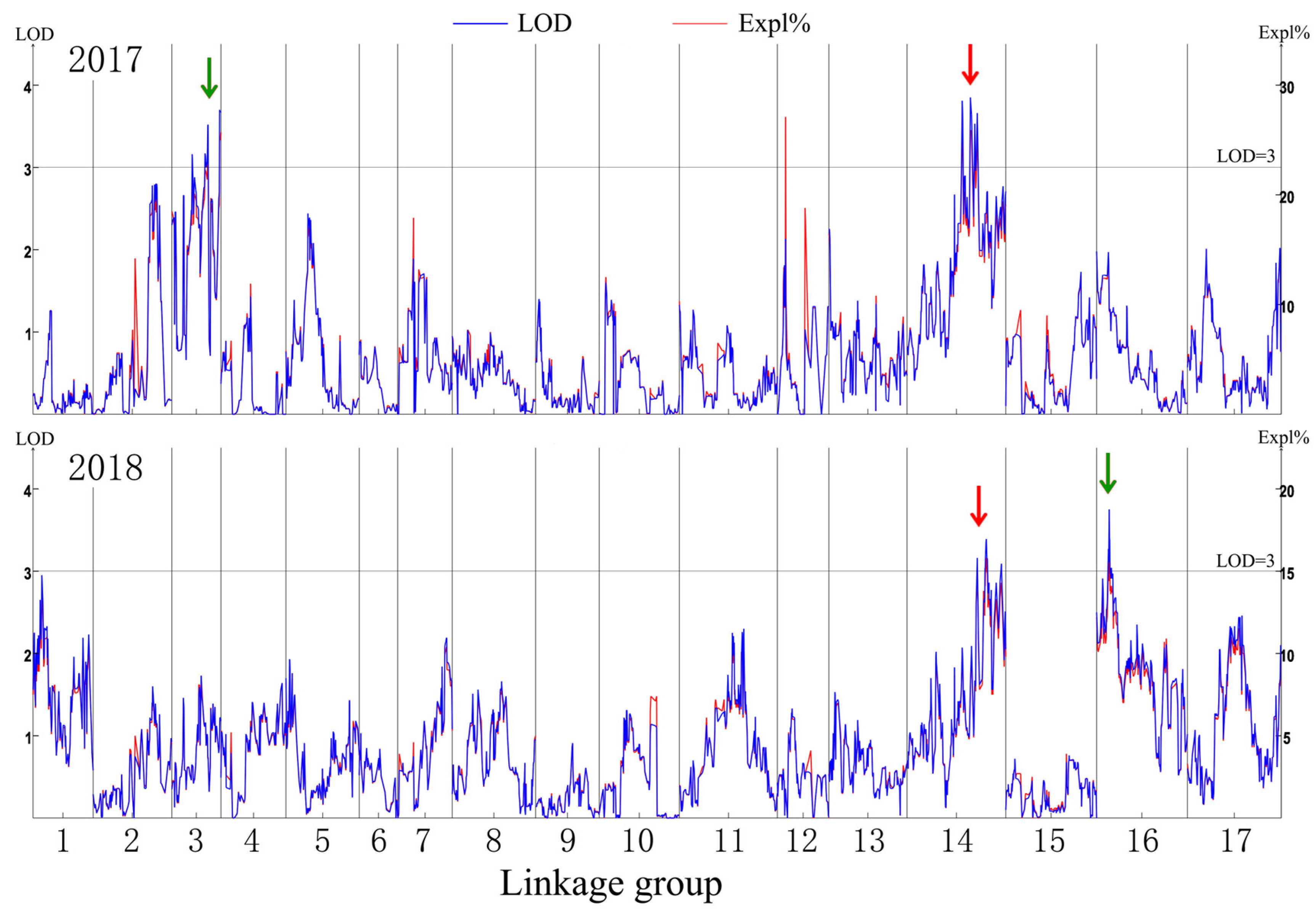
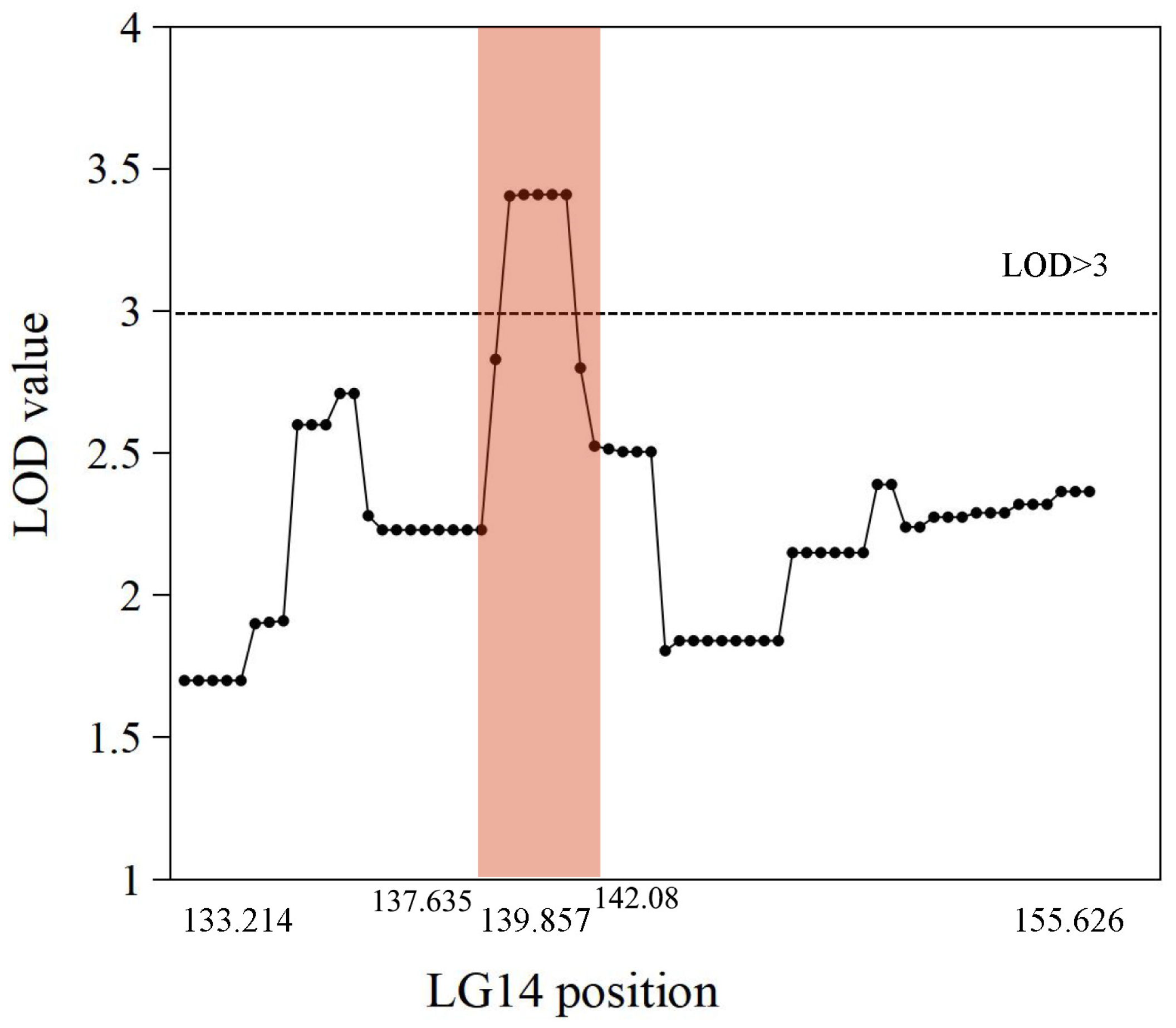
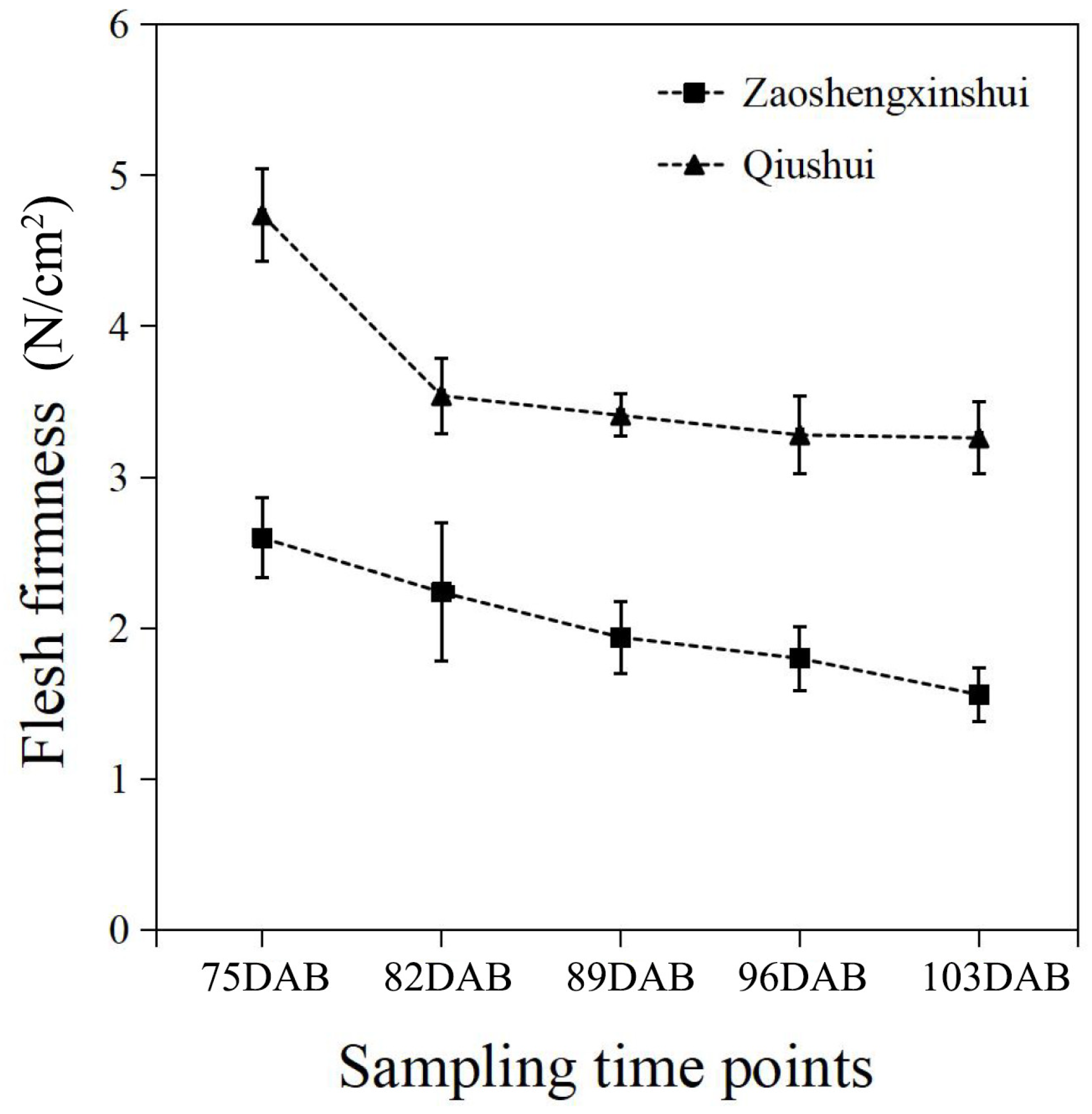
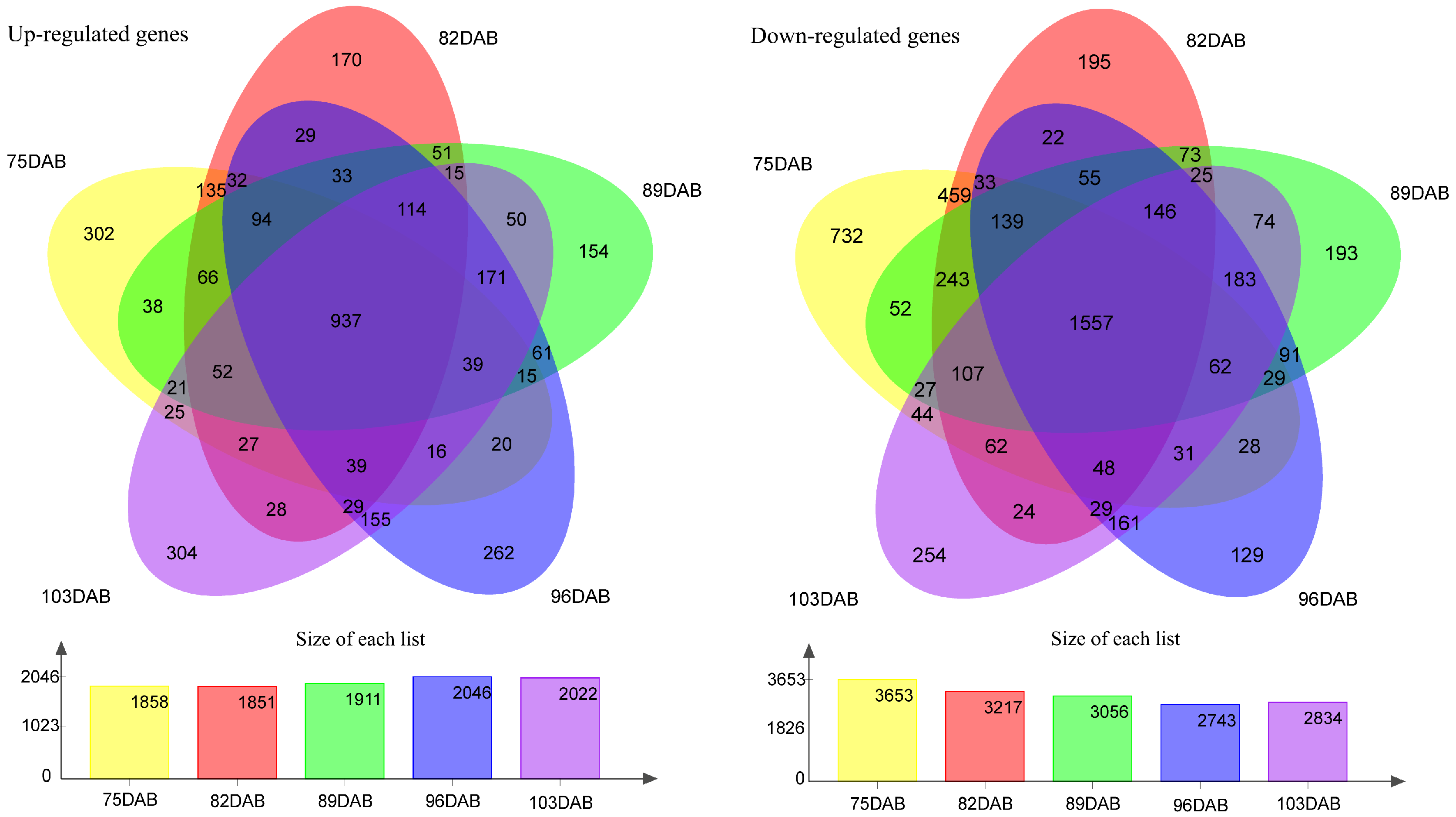
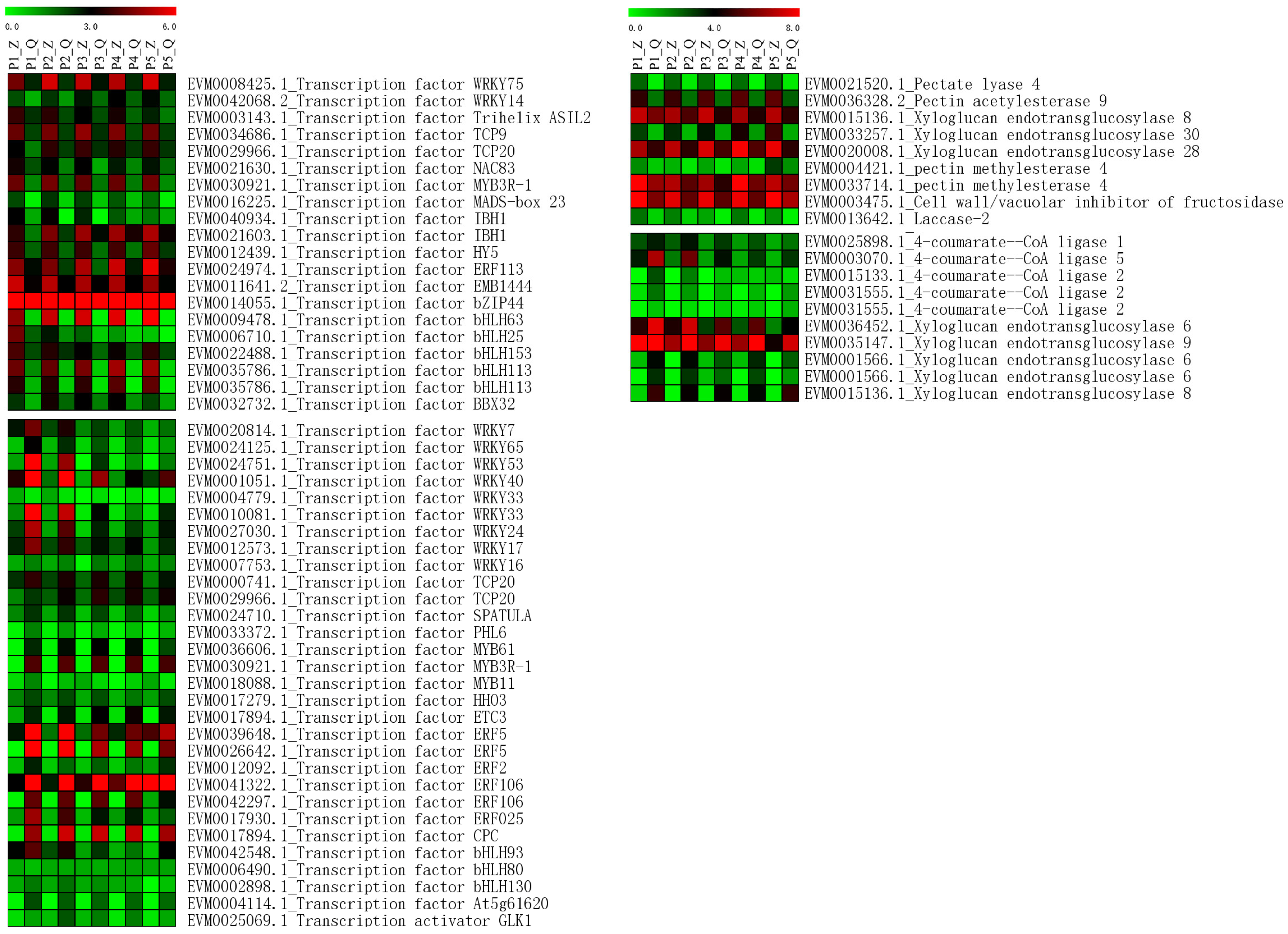


| Marker | Genotype | Phenotype Flesh Firmness (N/cm2) | Number of Offspring |
|---|---|---|---|
| Marker 1512129 | CT | 2.89 | 43 |
| TT | 2.38 | 41 |
| ‘Cuiguan’ Genome | NR Description | Position |
|---|---|---|
| EVM0024354 | calponin homology domain-containing protein DDB_G0272472 | Chr13_24912662_24915561 |
| EVM0013403 | transcription factor HY5-like | Chr13_24920364_24922189 |
| EVM0013050 | 50S ribosomal protein L18 | Chr13_24949033_24950857 |
| EVM0002943 | glycosyltransferase | Chr13_24961143_24963335 |
| EVM0033861 | DNA repair RAD52 | Chr13_24967729_24970208 |
| EVM0018394 | hsp70 nucleotide exchange factor FES1 | Chr13_24971327_24973746 |
| EVM0012154 | U2 small nuclear ribonucleoprotein | Chr13_24981861_24985672 |
| EVM0027569 | xyloglucan endotransglucosylase 1 | Chr13_25023725_25026479 |
| EVM0017503 | respiratory burst oxidase | Chr13_25059679_25063772 |
| EVM0021817 | 40S ribosomal protein S27-2 | Chr13_25208357_25209651 |
| EVM0012080 | NRT1/PTR FAMILY 6.1 | Chr13_25258968_25261202 |
| EVM0024974 | ethylene-responsive transcription factor ERF113-like | Chr13_25312766_25315579 |
| EVM0037641 | B2_DAUCA B2 | Chr13_25333710_25334935 |
Disclaimer/Publisher’s Note: The statements, opinions and data contained in all publications are solely those of the individual author(s) and contributor(s) and not of MDPI and/or the editor(s). MDPI and/or the editor(s) disclaim responsibility for any injury to people or property resulting from any ideas, methods, instructions or products referred to in the content. |
© 2024 by the authors. Licensee MDPI, Basel, Switzerland. This article is an open access article distributed under the terms and conditions of the Creative Commons Attribution (CC BY) license (https://creativecommons.org/licenses/by/4.0/).
Share and Cite
Jiang, S.; Zhang, J.; Wang, X.; Shi, C.; Luo, J. Identification of Candidate Genes Associated with Flesh Firmness by Combining QTL Mapping and Transcriptome Profiling in Pyrus pyrifolia. Int. J. Mol. Sci. 2024, 25, 11347. https://doi.org/10.3390/ijms252111347
Jiang S, Zhang J, Wang X, Shi C, Luo J. Identification of Candidate Genes Associated with Flesh Firmness by Combining QTL Mapping and Transcriptome Profiling in Pyrus pyrifolia. International Journal of Molecular Sciences. 2024; 25(21):11347. https://doi.org/10.3390/ijms252111347
Chicago/Turabian StyleJiang, Shuang, Jiaying Zhang, Xiaoqing Wang, Chunhui Shi, and Jun Luo. 2024. "Identification of Candidate Genes Associated with Flesh Firmness by Combining QTL Mapping and Transcriptome Profiling in Pyrus pyrifolia" International Journal of Molecular Sciences 25, no. 21: 11347. https://doi.org/10.3390/ijms252111347
APA StyleJiang, S., Zhang, J., Wang, X., Shi, C., & Luo, J. (2024). Identification of Candidate Genes Associated with Flesh Firmness by Combining QTL Mapping and Transcriptome Profiling in Pyrus pyrifolia. International Journal of Molecular Sciences, 25(21), 11347. https://doi.org/10.3390/ijms252111347





